Thanks for your support! If you make a purchase using our links in this article, we may make a commission. And, as an Amazon Associate, I earn from qualifying purchases. See the full disclosure here.
Is it better to tow a car (toad) with your motorhome or tow a camper trailer with your truck?
To tow or toad, that is the question: Whether ‘tis nobler in the mind to suffer The sway and hitch of towing Or take the dolphining and flat-tow of a dinghy And by opposing traffic: to sit among, or above; In comfort; and by a sleep, to say we enjoy.
If Shakespeare’s Hamlet were to entertain the idea of joining the RV lifestyle, which would he choose? Would it be a towable travel trailer or a drivable motorhome? Since he’s from Denmark, more than likely he’d probably buy a class B. Campervans are the most popular RV throughout Europe and the British Isles.
In the early 1960s, the Dodge Travco was given the title of the first manufactured motorhome. Previous to that creation, there were a few individual motorhomes made by individuals, but the Travco was the first to be produced in a factory. This started the great debate among RVers. Which RV is better; a drivable motorhome or a towable travel trailer?
By extension, having a passenger vehicle available while camping is apart of that debate. Tow a trailer or haul a toad? There are advantages either way. To help you decide which side of the fence is best for you, we’ll explore the many factors involved in the decision making process and the benefits of each class of RV.
The Best Way to Know if you Should Tow or Toad is to Rent
The easiest and most affordable way to determine what category of RV is best for you and your family is to rent. Peer-to-peer rental companies like Outdoorsy and RVshare allow you to rent coaches from individual RV owners. You can choose from thousands nationwide in any category.
When you pick it up, the owner will give you a tour of the RV to familiarize you with all of the functions. They will answer all of your questions and may share some of their wisdom. The best part is you’ll get to experience RVs that are owned by real people, not corporations.
You’ll have the benefit of trying out different floorplans, sizes, and other unique features. Rent as many as you want, as often as you want. There are peer reviews and various other tips you can look through to enhance the camping experience.
Make a Priority List to Determine if You Should Tow or Toad
Before you begin your RV search, you and your family must begin by creating a priority list. Everyone wants the best RV for the money, but first, define what best means. Here are a few topics to mull over to guide you through your priority list.
Can Your Current Every Day Vehicle Tow a Travel Trailer or 5th Wheel?
If you plan to tow your RV, consider what your current vehicle’s towing capacity is, or if it’s equipped to tow at all. If it doesn’t have a tow package, you may have to buy a new vehicle.
Can Your Motorhome Tow Your Car, Truck or Jeep?
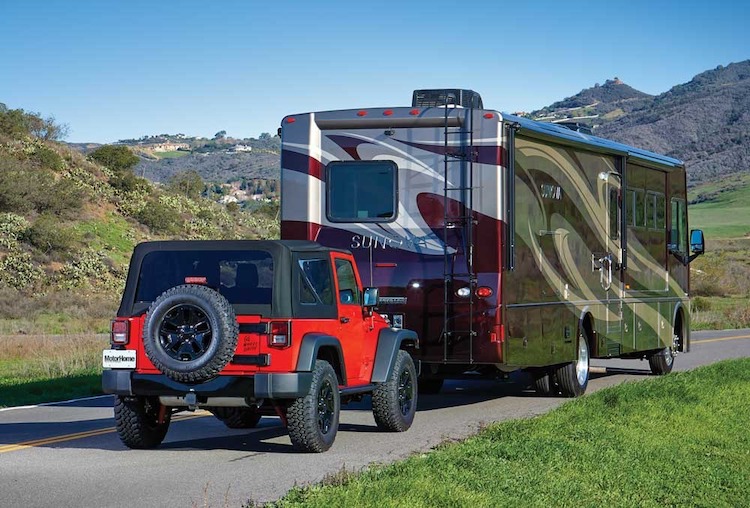
If you purchase a motorhome and want to bring your passenger vehicle, then you have the issue of towing it. Can it be flat-towed or do you need a trailer? Check out our feature article that discusses this in detail.
It May Cost Quite a Bit to Tow or Toad!
You may end up having to buy a truck big enough to tow your camper. Or you might have to buy a Motorhome big enough to tow your car. Or, like in our case, you might need to buy a car that is light enough for your motorhome to tow!
Needs, Wants, and Compromises
RVs vary greatly when it comes to features and amenities. The most basic models give you a dry place to sleep, storage, and counter space. The most luxurious rival million-dollar homes with residential appliances, full media systems, two full bathrooms, and multiple bedrooms. Compromises can save you money like wet baths that combine the shower and commode space.
Those that want to enjoy the interior space more often want to have more creature comforts. Outdoor enthusiasts who spend the day hiking, kayaking, or are away from the RV most of the time have different needs. Their RVs must be comfortable to sleep in, have good kitchens for food prep, and have the utility function to hold their equipment.
Compromising on those features you know you’ll rarely use can save money. Here are a few things to consider:
- A wet bath instead of a dry bath
- Bunk beds versus a bunkhouse
- Privacy curtains over doors
- A single TV on an arm instead of multiple TVs
- 8 cubic foot fridge with a pantry versus a residential refrigerator
- Queen-size bed over a king
- Regular package versus all-season package
Safety
RV safety standards are different than passenger vehicle standards. What can be said is RVs are safe when driven properly and responsibly. Advances in safety equipment and construction practices are continually reviewed and monitored.
Both drivable and towable RVs account for less than a third of passenger vehicle accidents in the United States every year. This is partially why RV insurance rates are so low.

Maneuverability
RVs, both towable and drivable are at their best when they are driving straight on highways. This isn’t always the case. Navigating surface streets and positioning into campsites are where drivers earn their stripes.
Whether you have a travel trailer on a ball hitch or a fifth wheel on a kingpin, the trick is getting the trailer to go the way you want it too. There are many videos and blogs with tips and tricks out there, but in the end, it boils down to how you get to Carnegie Hall; practice, practice, practice.
Backup cameras have made it a lot easier. In fact, A law was passed by the federal government in 2007 stating that all new vehicles by 2018 are required to have backup cameras. This affected motorhomes directly. The RV industry took it a step further. While travel trailers aren’t required, most builders started prewiring their coaches and adding brackets as a standard feature.
Turning radius is another maneuverability issue. Towables require a wider turn radius to avoid hopping the curb. Motorhomes must also drive more into the intersection before making a turn to clear the back wheels. Class B RV and truck campers are the exceptions since their overall wheelbases fit standard size vehicles.
Floorplans Variation
Full-size and mid-size (25 to 40 feet) travel trailers have the most variation when it comes to floorplans of any category of RV. One school of thought is to start with full-size travel trailers to determine which basic floorplan fits your needs best.
Drivable RVs that Can Tow a Vehicle Behind Them
Drivable RVs, also known as motorhomes, offer features that towables don’t. The driver’s area offers recliner-like pilot seats and panoramic windshields above traffic. This makes the traveling experience just as enjoyable as stationary camping. It also gives others the ability to enjoy the coach area while moving. These motorhomes are excellent for towing vehicles behind them because of their strong diesel engine.
Class A Diesels
Class A diesel motorhomes are the most expensive category. They feature the best materials, epic technology, and top-end residential appliances. These motorhomes are excellent for towing vehicles behind them because of their strong diesel engine.
Class A Gassers
In the past few years, gassers have been modeled after their diesel counterpart to have residential features, but have prices that range between $100,000 to $750,000. They measure from 27- 40 feet in length and are easy to drive. Gas Powered motorhomes are also great for towing a car behind them.
Super Class C
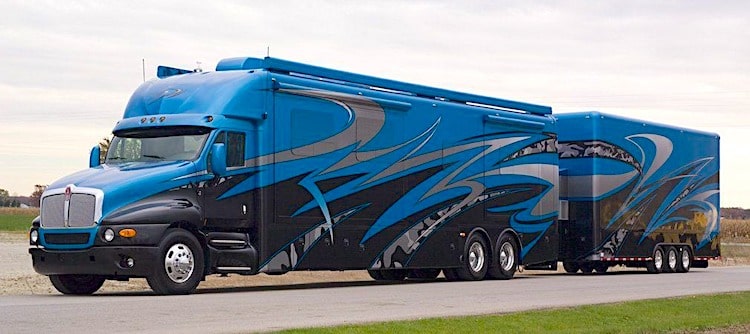
When Freightliner became a vendor for the RV industry, the superclass C was born. This category matches up to the class A diesel when comparing the interior features, chassis, and other components. The difference is the front Freightliner truck section. To the eye, it looks like a motorhome built on a semi-truck. Some come with the over cab loft space. Super C RVs can actually tow the heaviest loads because of the heavy-duty frame they are built on.
Class C
Class C motorhomes are built on either full-size van or pickup truck chassis. They’re easy to spot with the overhead loft section above the driver’s cabin. They come in lengths that range from 25- 38 feet in length. Many in this category are under $100,000. Some find them less cumbersome and are excellent for young families. Class C RVs are all over the board when it comes to towing capacity. Our Class C can tow up to 6,500 lbs but the hitch we have is only rated to tow up to 5,000 lbs.
Class B
The millennial generation has made the class B campervan popular in the United States with the #VanLife on social media, but active Baby Boomers are finding the smallest drivable RV perfect for their style of RVing.
They are the easiest RV to drive since they fit into full-size van bodies. What they lack in space they make up in maneuverability and designer features. Keep in mind that many of them have price tags that rival class A assets. The whole idea of a Class B motorhome is that you don’t need to tow a car because the campervan usually gets great gas mileage and it is like driving a car.
Truck Campers
Truck campers sit inside pickup truck beds. Instead of tow capacity, they are based on a truck’s payload limit. Like fifth wheels, you’ll find them in either half-ton sizes or full-size. Manufacturers also cater to short, standard, and long bed trucks. Independent makers allow you to custom design fabrics, wood, and features.
Towable Travel Trailers
Towable travel trailers offer a different experience than drivable RV motorhomes. They are generally more affordable, have more diverse floorplans, and vary in weight. And there is a huge variety of travel trailers you can tow. Some weigh under 2,000 lbs and others go over 7,000 lbs. So your tow vehicle’s towing capacity is very important when deciding on a travel trailer.
Fifth Wheels
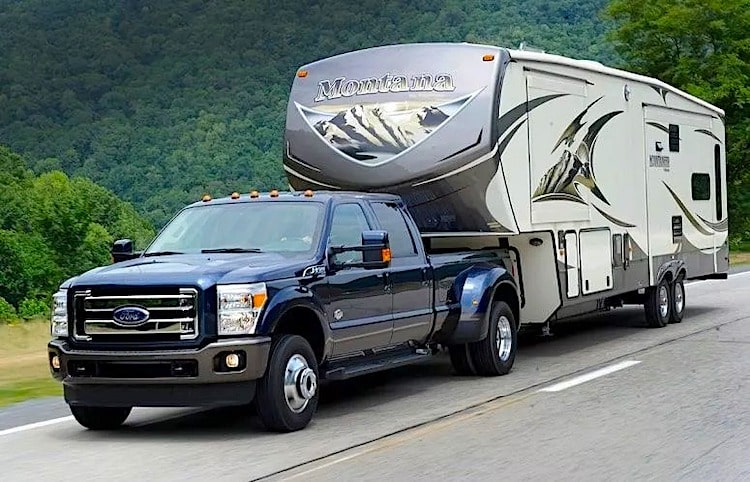
Fifth wheels offer the best-upgraded features in a towable RV. Many who give up their permanent home to live in their coach prefer this category because of the home-like features. Fifth wheels hook up inside the bed of a pickup truck. And 5th wheel typically requires a larger pickup truck to tow them.
They come in two levels. Half-tons are made for trucks like the Ford F-150 or Ram 1500. Full-size models are towable for trucks at the three-quarter or one-ton levels like the Chevy Silverado 2500 or GMC Sierra 3500.
Travel Trailers
Full-size travel trailers range between 30-40 feet. You’ll need an SUV or pickup truck with the most towing capacity possible. They have the most luxurious features, multiple slideouts, and many different floorplans. Some can sleep up to 10 people.
Lightweight Travel Trailers
With fuel efficiency on everybody’s mind, lightweight travel trailers give you the most amount of space and are still mid-size SUV-friendly. Their lightweight construction materials give manufacturers the ability to keep them under 6,000 pounds. You’ll find quality interior features inside this popular category and easy handling.
Hybrids
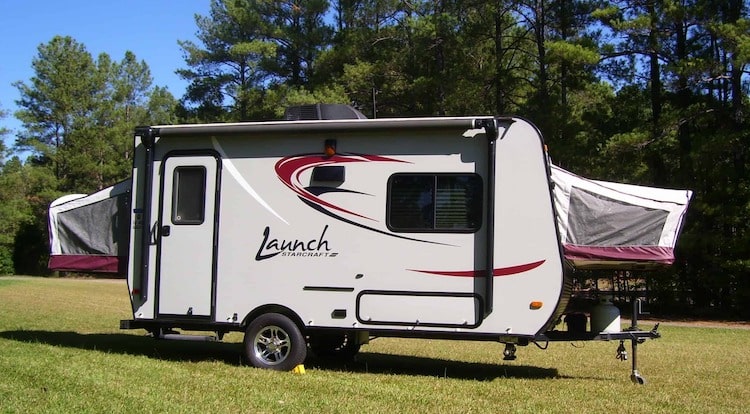
Hybrid travel trailers give you the best of travel trailers and the expandable beds of a pop-up. They are great space savers since the beds expand out. Some have three beds on them for larger families. For rainy nights, you can set everything up inside and stay dry. One of the biggest advantages of a hybrid travel trailer is that it is lighter than most trailers which allows for a wider variety of vehicles that can tow them.
Towable Campers
Campers are towable but can be considered separate from travel trailers. Their small size and ultra-lightweight create a different RV experience from travel trailers. They generally appeal to young couples and young families. Campers are the most budget-friendly of all RVs making them the most accessible to anyone ready to hit the road.
Hard Side Pop-Ups
Hard side pop-ups like A-frame campers have been around as long as soft-sided ones. They give you the insulated walls like a travel trailer. Kitchen and climate control features are placed strategically so storage and sleeping space aren’t sacrificed. Minivans and small SUVs are great tow vehicles for this RV.
Soft Side Pop-Ups
Soft side pop-ups weigh as little as 1,000 pounds or as big as 3,400 pounds. Features vary from basic to complete, depending on what type of living conditions you want. The vinyl sides are waterproof and do hold heat and air conditioning well. Weekend campers find this RV easy to store in their garage and low cost to maintain.
Teardrops
Originally, a teardrop camper was an inside bed with a kitchen set up in the rear hatch outside. As you’ll see from our video, they’ve come a long way. Teardrop campers are the smallest RVs, but there are so many new features two people can enjoy. Deluxe models now have bathrooms, media centers, beds that fold to dinettes, and dual climate control. Since Tear Drops are so light they are easy to tow for most vehicles and even some cars can tow them!
Make Your Decision to Tow or be Towed Fun!
Confused yet? Many of the different categories end up bleeding into each other. Small class A gassers have similar prices as longer class Cs. Pop-up campers can be just as nice as lightweight travel trailers.
As we mentioned before, the best way to decide whether to tow a trailer or toad a passenger vehicle with a motorhome is to create a priority list and rent a few of them. Most importantly, have fun doing it. The reason the RV community has lasted since the 1930s is how much they enjoy the lifestyle. Even though this is a big decision, this is your first RV adventure. Enjoy the experience.

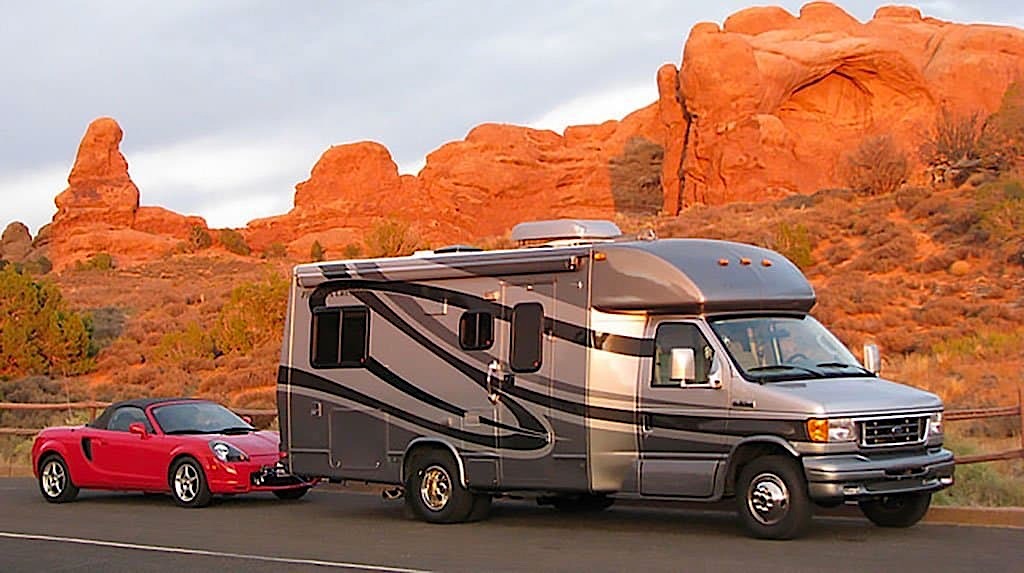


Do I have any concerns towing a Forest River Wolf Cub trailer with a 2020 Dodge Caravan. The numbers say i can. Trailer weight is 3100 lbs. (dry), and towing capacity for the van is 3500 lbs.